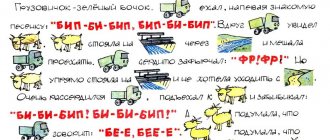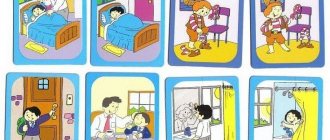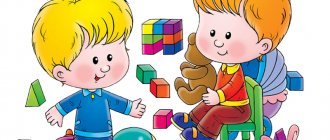Didactic games for speech development in the second junior group
Presentation
Didactic games for speech development in the second junior group
Completed by: teacher Krieger G.G.
Didactic game. "Extra item"
Goal: to learn to group and qualify objects, develop verbal and logical thinking, cause-and-effect and logical relationships, visual memory, the ability to conduct a dialogue, the ability to find an extra object and explain why it is unnecessary.
We play this game in classes on speech development, familiarization with the world around us. Children look at the pictures, name what is depicted on them, then, using reasoning, find the extra object.
“Who eats what?”
Goal: to introduce what some species of animals eat, to develop logical thinking, fine motor skills, and speech.
In this game, animals are glued to clothespins. Children enjoy “feeding” the animals their favorite food, saying the name of the animals, the name of the food, and you can also ask what sounds the animals make.
This game can be played both in class and during free activities.
"Quick Fingers"
Goal: be the fastest to put rubber bands on your fingers as shown on the task cards, to develop fine motor skills, memory, and thinking.
We play this game in classes on FEMP, speech development, familiarization with the outside world, and in their free time children play with pleasure.
"What does it look like?"
Goal: to teach children to create images in their imagination based on schematic representations of objects, to develop thinking, memory, and speech.
The good thing about this game is that it can be played in all classes. Develops logical thinking, coherent speech, memory.
"Children on a Walk"
Goal: to teach children to create images in their imagination based on schematic images of objects, to develop memory and coherent speech.
We play in physical education classes, speech development, ecology, and familiarization with the outside world.
“What did the artist mix up?”
Goal: to develop attention, visual perception, coherent speech.
In a class on speech development, this game makes it possible to solve many problems: the development of attention (look at the picture and say what’s wrong in it), logical thinking (the frog is sitting in a nest - where does it live?), the development of coherent speech (let’s make a fantastic story)
We also take this game to classes to familiarize ourselves with the world around us.
“Whose subject?”
Goal: to develop imagination, attention, coherent speech, logical thinking.
On the topic “Family”, children learn to determine who owns what, and discuss why this item was given to, for example, grandmother or mother (grandmother makes jam, mother wears high-heeled shoes).
The game is interesting in classes on speech development, familiarization with the outside world, art, etc.
"Games with clothespins"
Goal: development of fine motor skills, coherent speech, creativity and logical thinking.
Children like this game because it can be played in all classes, during children's morning reception, and during free activities.
Develops fine motor skills, creativity and perseverance.
"Mnemotables of tongue twisters"
Goal: development of visual and auditory memory, visual and auditory attention, imaginative thinking, imagination, speech.
Using mnemonic tables, tongue twisters are well remembered and visual perception is developed, which is why we use them in all classes.
"Riddles-answers"
Goal: to teach children to correlate the verbal form of describing objects with the graphic form.
We play this game in classes on speech development (a riddle about a hedgehog - describe it), familiarization with the world around us (tell us about a hedgehog - what it is like, where it lives, what it likes to eat), etc.
You can play with the whole group of children, or in subgroups.



